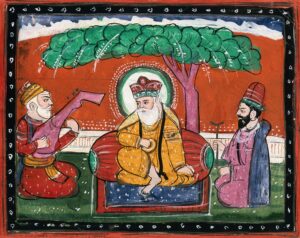Guru Ram Das Ji was born on September 24, 1534, in Lahore, in present-day Pakistan. His birth name was Bhai Jetha. Orphaned at the young age of seven, he was raised by his maternal grandmother, who instilled in him values of hard work, honesty, and spiritual devotion. Even as a child, Bhai Jetha had a humble and service-oriented nature. When he was a teenager, he traveled to Goindwal Sahib, where he met Guru Amar Das Ji, the third Guru. Captivated by the Guru’s spiritual presence and teachings, Bhai Jetha dedicated his life to selfless service and became one of the Guru’s most trusted and loyal disciples.
Bhai Jetha’s devotion and humility were unmatched. He worked tirelessly in seva (selfless service), whether it was fetching water, cleaning, or assisting in the construction of new religious centers. Impressed by his sincerity and spiritual wisdom, Guru Amar Das Ji gave his daughter, Bibi Bhani, in marriage to Bhai Jetha. He thus became part of the Guru’s household, but never let that alter his humble conduct. He continued to serve the Guru and the Sangat (congregation) without pride or entitlement. In 1574, before departing from this world, Guru Amar Das Ji appointed Bhai Jetha as the next Guru, bestowing him with the name Guru Ram Das, meaning “Servant of God”.
As the fourth Guru, Guru Ram Das Ji’s contributions were both spiritual and practical. One of his most significant achievements was the founding of the city of Amritsar. He selected the site, purchased the land, and began the excavation of a sacred tank called Amrit Sarovar (Pool of Nectar), around which the future Harmandir Sahib (Golden Temple) would be built. He envisioned Amritsar as a spiritual center open to all people, regardless of caste or creed, and its development laid the foundation for the spiritual and political growth of the Sikh community.
Guru Ram Das Ji also continued the missionary work started by Guru Amar Das Ji. He strengthened the Manji system, appointing Sikh preachers and representatives in various regions to spread the Guru’s message. He emphasized the importance of Naam Simran (remembrance of God’s Name), honest living, humility, and community service. Guru Ram Das Ji composed 638 hymns, many of which are included in the Guru Granth Sahib. His hymns reflect deep devotion, love for God, and guidance for spiritual seekers. His compositions are also recited during Anand Karaj, the Sikh marriage ceremony, which he institutionalized — replacing older Vedic rituals with a spiritual and egalitarian Sikh alternative.
Guru Ram Das Ji led the Sikh community during a time of growing political tension with the Mughal empire, yet he maintained a path of peace and spiritual strength. He continued the Langar tradition and made the practice of eating together, without regard to caste or status, a central aspect of community life. His leadership emphasized inclusion, kindness, and a balance between spiritual and worldly responsibilities.
As he approached the end of his life in 1581, Guru Ram Das Ji chose his youngest and most capable son, Arjan Dev Ji, as his successor. He personally prepared him to lead the Sikh community with wisdom and grace. Guru Ram Das Ji left his mortal body on September 1, 1581, at the age of 47, but his legacy continues to live on in the spiritual heart of Sikhism — Amritsar — and in the deep devotional hymns he composed.















 Beyond its religious functions, the Gurdwara serves as a hub for community activities, bringing together the Sikh sangat for prayers, kirtan, and community events. The Gurudwara Baba Deep Singh affiliation underscores its dedication to upholding Sikh principles, contributing to the rich cultural tapestry of the Ganganagar area.
Beyond its religious functions, the Gurdwara serves as a hub for community activities, bringing together the Sikh sangat for prayers, kirtan, and community events. The Gurudwara Baba Deep Singh affiliation underscores its dedication to upholding Sikh principles, contributing to the rich cultural tapestry of the Ganganagar area.